
It’s been one month since the largest climate march in history, and recent “Climate Action” pledges from global leaders like the Department of Defense, President Obama and the United Nations do not add up to what communities need.
The People’s Climate March on Sunday September 21, 2014 was a major historic event. It was historic because of the unprecedented numbers – 400,000 people came out to march. It was historic because the participants and leaders of the march were made up of primarily people of color on the frontlines of the climate and economic crises: communities impacted by Hurricane Sandy, youth of color doing environmental justice work, and indigenous peoples from around the world led a broad march from many sectors including faith communities, labor, and more. For Grassroots Global Justice Alliance (GGJ), as co-anchor of the Our Power Campaign, it was historic to mobilize for this march because of the way the grassroots organizing sector and climate policy organizations came together to collaborate in the planning of the march, and laid the groundwork for strengthened relationships and a broader united movement for climate justice.
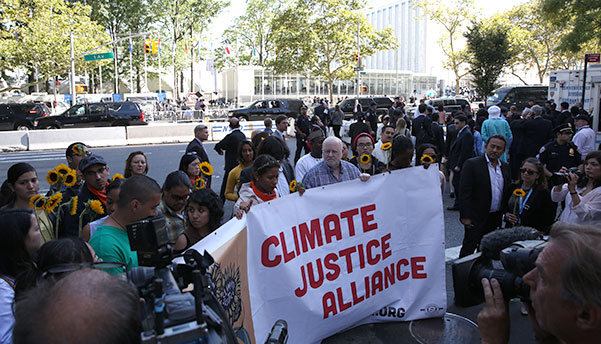 Members of the Our Power Campaign attempting to read and deliver a statement to the UN. (Photo courtesy of Sha Grogan-Brown)
Members of the Our Power Campaign attempting to read and deliver a statement to the UN. (Photo courtesy of Sha Grogan-Brown)
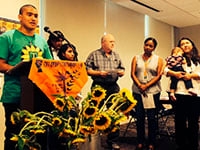 Members of the Our Power Campaign reading the statement at the People’s Tribunal before delivering it to the UN. (Photo courtesy of Sha Grogan-Brown)In days following the march, people took action to pressure the United Nations (UN) and global leaders to take real community-led action on Climate Change. On Monday September 22, Occupy Wall Street activists responded to a call to action from grassroots organizers of the Our Power Campaign and organized the Flood Wall Street mass sit-in.On Monday September 22 and Tuesday September 23, the Our Power Campaign held a People’s Climate Justice Summit and a People’s Tribunal to offer up community-led solutions and call out the False Promises that the UN calls “Climate Action,” calling on global leaders to catch up to communities on the ground who know what kind of Climate Action they really need.
Members of the Our Power Campaign reading the statement at the People’s Tribunal before delivering it to the UN. (Photo courtesy of Sha Grogan-Brown)In days following the march, people took action to pressure the United Nations (UN) and global leaders to take real community-led action on Climate Change. On Monday September 22, Occupy Wall Street activists responded to a call to action from grassroots organizers of the Our Power Campaign and organized the Flood Wall Street mass sit-in.On Monday September 22 and Tuesday September 23, the Our Power Campaign held a People’s Climate Justice Summit and a People’s Tribunal to offer up community-led solutions and call out the False Promises that the UN calls “Climate Action,” calling on global leaders to catch up to communities on the ground who know what kind of Climate Action they really need.
Unfortunately, the UN response was far from historic. The UN Climate Summit’s branding was deceptive: “I’m for Climate Action.” At first glance, that may seem like a good thing. We want action on climate, right? However, what the UN calls “Climate Action” is not the kind of action that communities around the globe need, so much so that on Tuesday September 23, members of the Our Power Campaign delivered a statement to the UN calling out their inaction on climate change and calling the UN Climate Summit “little more than a pep rally pushing carbon trading offsets and weak voluntary or limited pledges for emission cuts leading up to the global climate treaty negotiations in Paris next year.”
President Obama’s response was disappointing as well. He shared the UN’s rhetoric about “taking action” and “reducing emissions” yet the pledges the US made will not get us anywhere close to where we need to be in order to prevent major climate catastrophes.
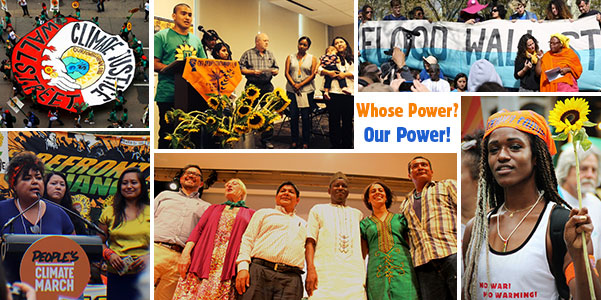 Photo collage from People’s Climate activities in New York City, September 2014. (Photo courtesy of Sha Grogan-Brown)
Photo collage from People’s Climate activities in New York City, September 2014. (Photo courtesy of Sha Grogan-Brown)
One month after the historic People’s Climate March in New York City, we still have yet to see global leaders make moves to take the “Climate Action” that frontline communities really need.
Last week, the Department of Defense (DOD) released their 2014 Climate Change Adaptation Roadmap, referring to climate change as a “threat multiplier.”
While it’s notable that the DOD finally acknowledges that the devastating impacts of climate change on the world’s most vulnerable populations are happening NOW rather than regarding climate change as a future threat, the majority of this report focuses on the impacts climate change will have on the US military’s “more than 7,000 bases, installations, and other facilities.” In fact, this report appears to make the case for increased militarization in places where the US has “assets,” and for more investment into expanding military operations.
Increased militarization will not make things better for poor and low-income families, is more likely to lead to greater political destabilization in many countries of the Global South and heightens police violence in communities of color, as recent events in Ferguson, Missouri clearly illustrated in the aftermath of the killing of Michael Brown.
The DOD is one of the world’s largest greenhouse gas emitters, and the single largest consumer of energy in the US, yet renewable energy has never represented more than 5% of total DOD facility consumption. The DOD should instead prioritize their mitigation plans and take on the lion’s share of US goals to reduce greenhouse gas emissions.
Despite inaction from global leaders, the People’s Climate activities last month were historic. But what happens next matters even more. Frontline communities in the US and around the world are struggling every day to survive this climate crisis, and are organizing around community solutions to climate change. GGJ members are working with organized communities around the world to create a new climate agreement, written with collective input from civil society, to influence upcoming UN climate meetings in what we are calling the People’s Climate process.
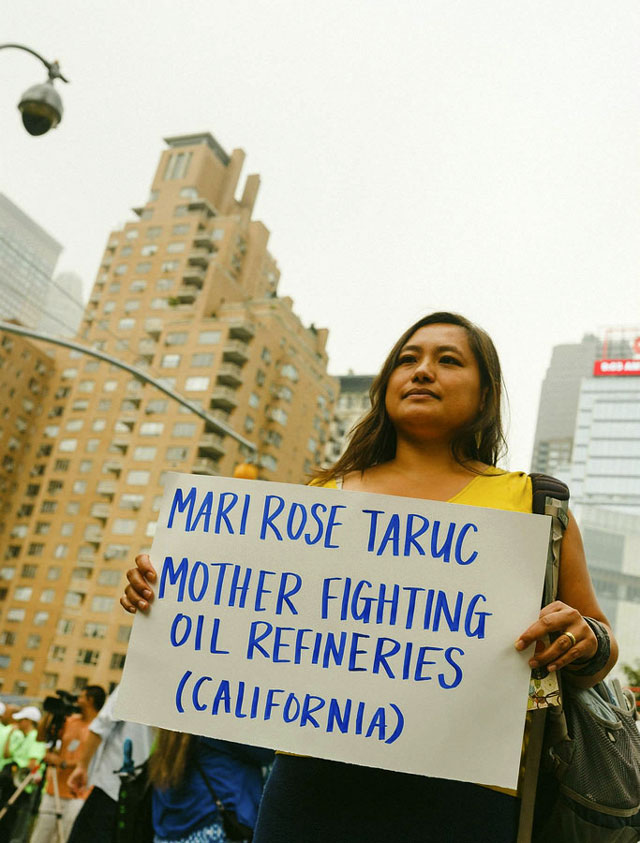 Mari Rose Taruc, Asian Pacific Environmental Network (APEN) at the People’s Climate March. (Photo: Megan Zapanta / APEN)
Mari Rose Taruc, Asian Pacific Environmental Network (APEN) at the People’s Climate March. (Photo: Megan Zapanta / APEN)
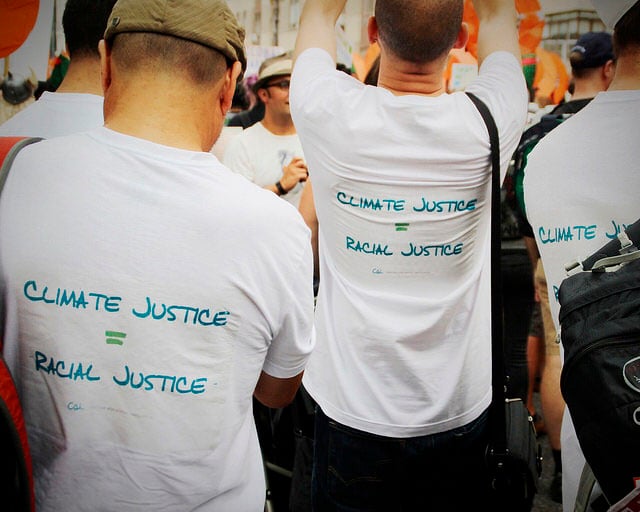 Climate Justice = Racial Justice. (Photo: Rae Breaux)
Climate Justice = Racial Justice. (Photo: Rae Breaux)
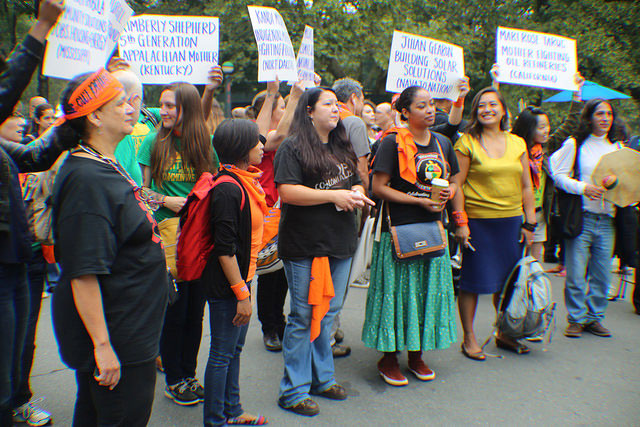 Our Power Campaign spokespeople at the People’s Climate March press conference. (Photo: Marjorie Childress)
Our Power Campaign spokespeople at the People’s Climate March press conference. (Photo: Marjorie Childress)
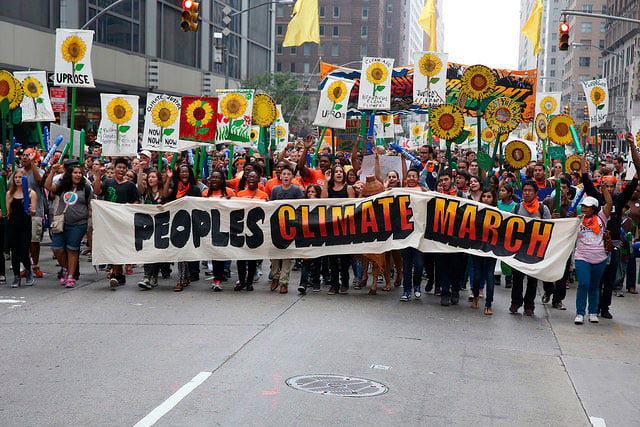 Youth of color on the frontlines of the climate crisis carrying the front banner. (Photo: Farhad Ebrahimi)
Youth of color on the frontlines of the climate crisis carrying the front banner. (Photo: Farhad Ebrahimi)
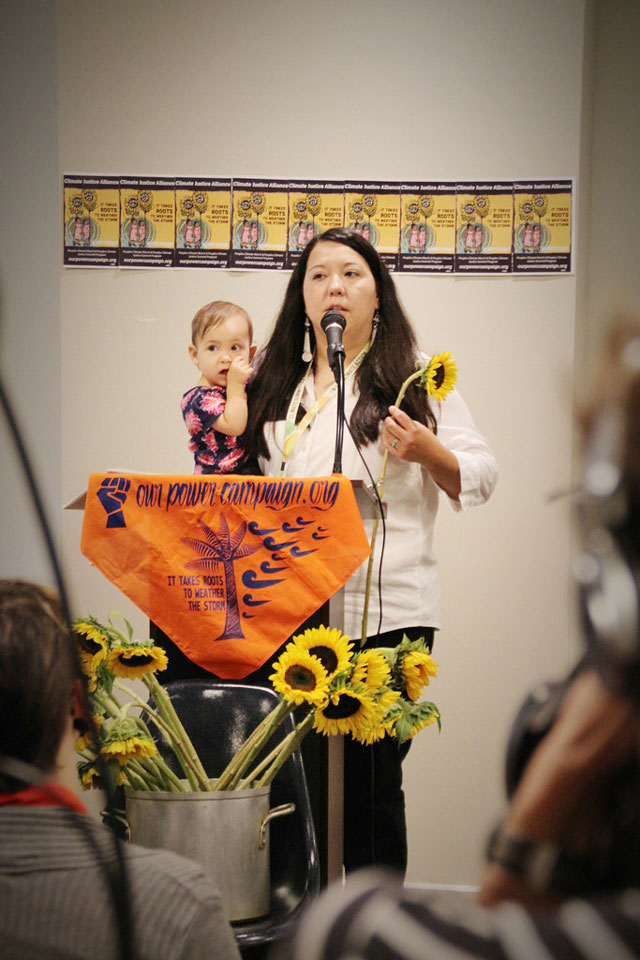 Kandi Mossett, Indigenous Environmental Network (IEN) and her daughter, preparing to deliver the Our Power Campaign statement to the United Nations. (Photo: Rae Breaux)
Kandi Mossett, Indigenous Environmental Network (IEN) and her daughter, preparing to deliver the Our Power Campaign statement to the United Nations. (Photo: Rae Breaux)
Follow GGJ to learn more about the People’s Climate process: ggjalliance.org, Twitter: @ggjalliance, Facebook: Grassroots Global Justice Alliance
Article summarizing the People’s Climate Justice Summit opening plenaries.
Defying Trump’s right-wing agenda from Day One
Inauguration Day is coming up soon, and at Truthout, we plan to defy Trump’s right-wing agenda from Day One.
Looking to the first year of Trump’s presidency, we know that the most vulnerable among us will be harmed. Militarized policing in U.S. cities and at the borders will intensify. The climate crisis will deteriorate further. The erosion of free speech has already begun, and we anticipate more attacks on journalism.
It will be a terrifying four years to produce social justice-driven journalism. But we’re not falling to despair, because we know there are reasons to believe in our collective power.
The stories we publish at Truthout are part of the antidote to creeping authoritarianism. And this year, we promise we will kick into an even higher gear to give you truthful news that cuts against the disinformation, vitriol, hate and violence. We promise to publish analyses that will serve the needs of the movements we all rely on to survive the next four years, and even build for the future. We promise to be responsive, to recognize you as members of our community with a vital stake and voice in this work.
Please show your support for Truthout with a tax-deductible donation (either once today or on a monthly basis).